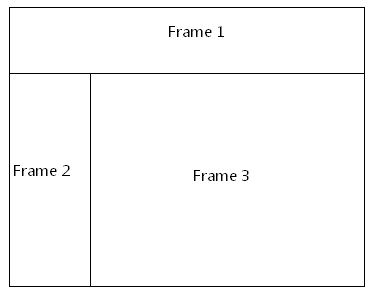17.15.2.23 longDesc
This element specifies an explicit relationship whose target is the long description of the frame. This description should supplement the short description provided by the title element. This property is analogous to the longdesc attribute on the frame element in HTML.
If this element is omitted, then no long description shall be associated with the given frame.
[Example: Consider a WordprocessingML document which serves as the frameset container for a frameset consisting of the following three frames:

The frameset properties for this document are specified by the following WordprocessingML within the web page settings:
<w:frameset>
…
<w:frame>
<w:name w:val="Frame 1" />
<w:title w:val="Menu bar" />
<w:longDesc r:id="rIdMenuBar" />
</w:frame>
<w:frameset>
<w:title w:val="Navigation and document collection" />
…
<w:frame>
<w:name w:val="Frame 2" />
<w:title w:val="Navigation bar" />
<w:longDesc r:id="rIdNavBar" />
</w:frame>
<w:frame>
<w:name w:val="Frame 3" />
<w:title w:val="Documents" />
<w:longDesc r:id="rIdDocs" />
</w:frame>
</w:frameset>
</w:frameset>The longDesc element specifies that the part targeted by the relationship with an id of rIdMenuBar must be used for supplementary information for Frame 1. Examining the contents of the corresponding relationship part item, we can see the targets for that relationship:
<Relationships … >
…
<Relationship Id="rIdMenuBar" TargetMode="External"
Type="http://purl.oclc.org/ooxml/officeDocument/relationships/hyperlink"
Target="myexample-desc.html#menubar" />
…
</Relationships>The corresponding relationship part item shows that the long description supplementary information for Frame 1 is located at myexample-desc.html#menubar, where myexample-desc.html describes #menubar as “This frame provides links to the major sections of the site: Home, Resources, Links, Help.” end example]
Attributes
Namespace: http://purl.oclc.or g/ooxml/officeDoc ument/relationshi ps
[Example: Consider an XML element which has the following id attribute:
<… r:id="rId10" />The markup specifies the associated relationship part with relationship ID rId1 contains the corresponding relationship information for the parent XML element. end example]
The possible values for this attribute are defined by the ST_RelationshipId simple type (22.8.2.1).
id (Relationship to Part)
Specifies the relationship ID to a specified part.
The specified relationship shall match the relationship type required by the parent element:
- http://purl.oclc.org/ooxml/officeDocument/relationships/customXml for the contentPart element
- http://purl.oclc.org/ooxml/officeDocument/relationships/footer for the footerReference element
- http://purl.oclc.org/ooxml/officeDocument/relationships/header for the headerReference element
- http://purl.oclc.org/ooxml/officeDocument/relationships/font for the embedBold, embedBoldItalic, embedItalic, or embedRegular elements
- http://purl.oclc.org/ooxml/officeDocument/relationships/printerSettings for the printerSettings element
- http://purl.oclc.org/ooxml/officeDocument/relationships/hyperlink for the longDesc or hyperlink element
[Note: The W3C XML Schema definition of this element’s content model (CT_Rel) is located in A.1. end note]